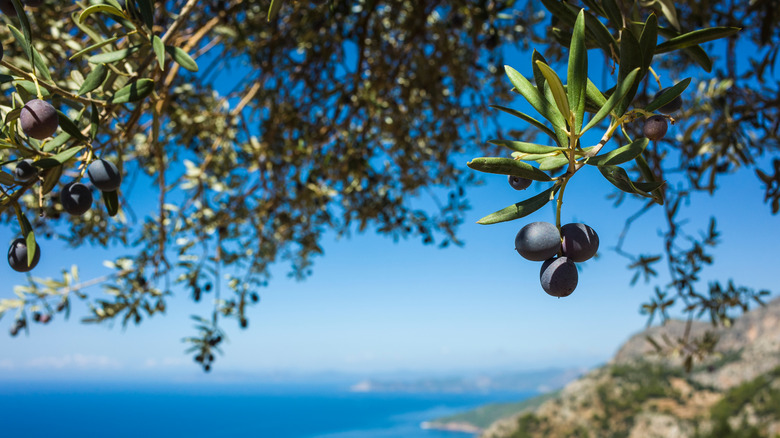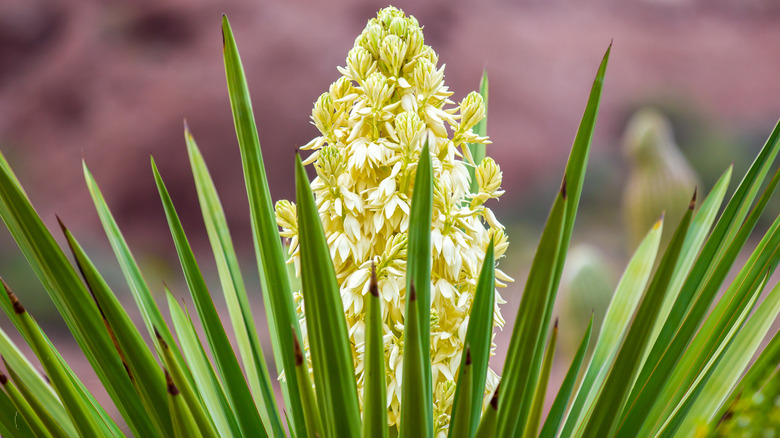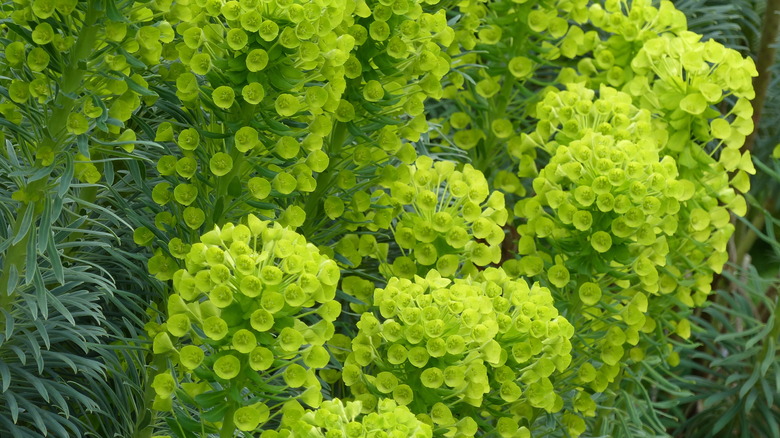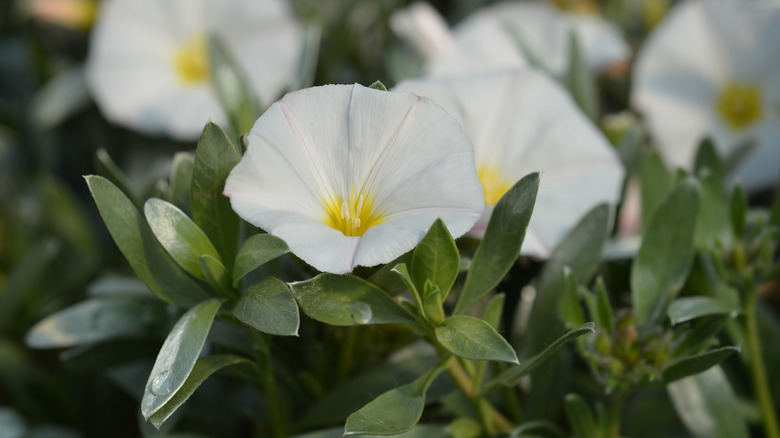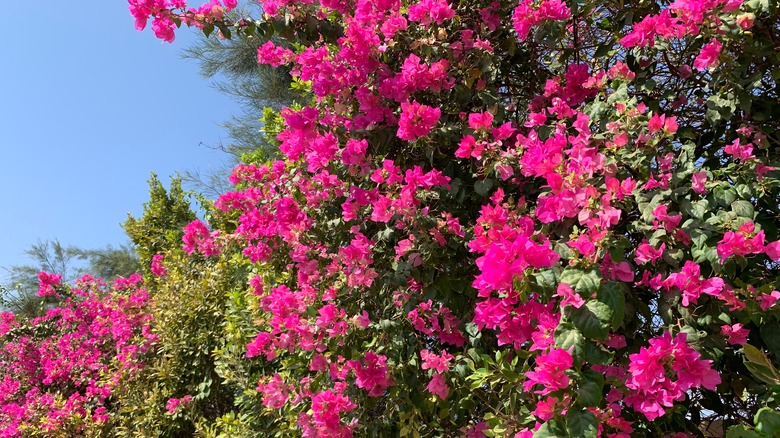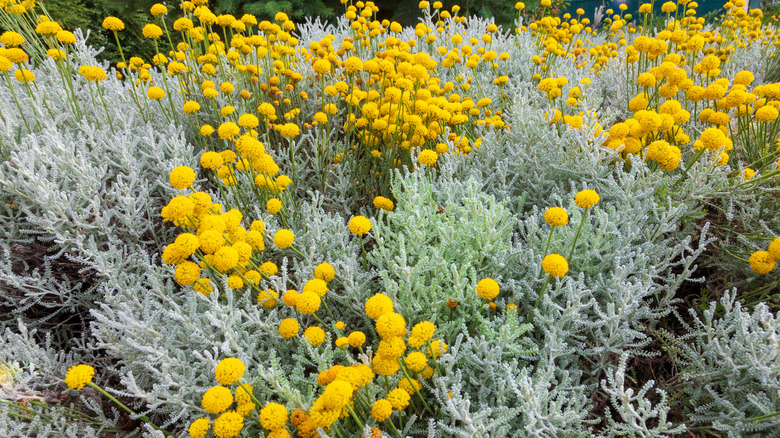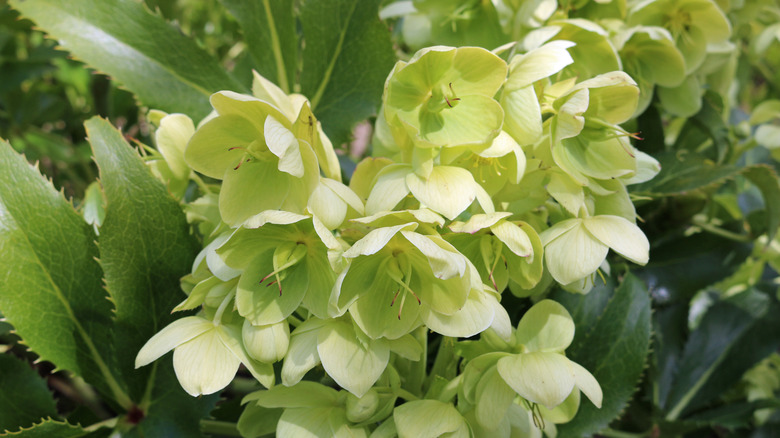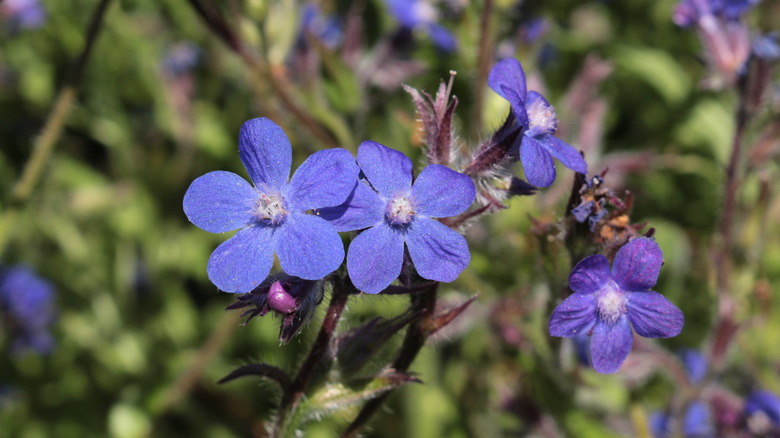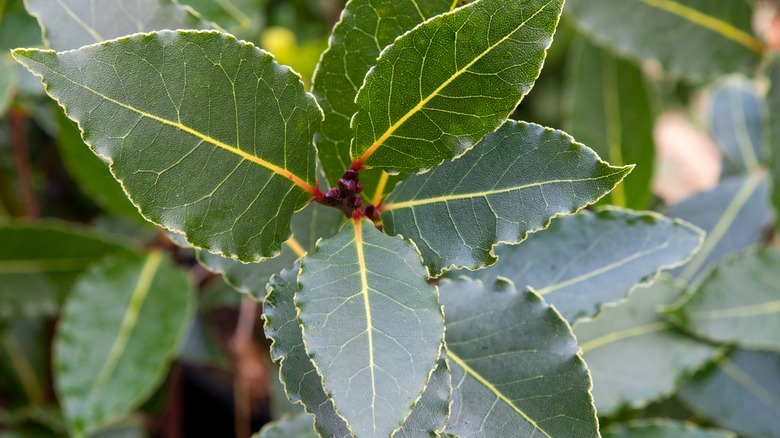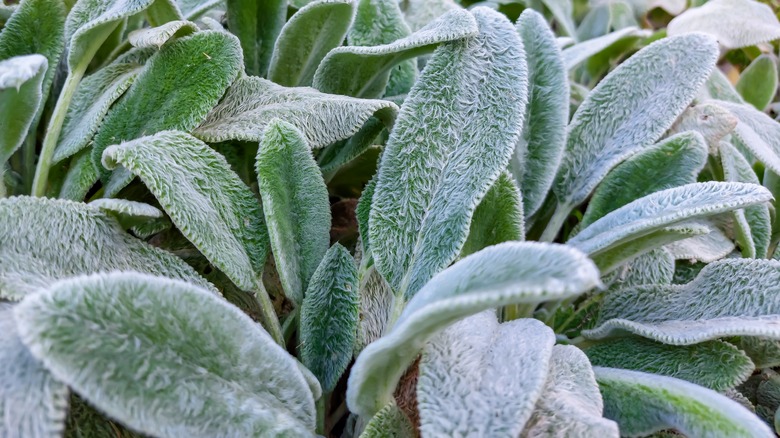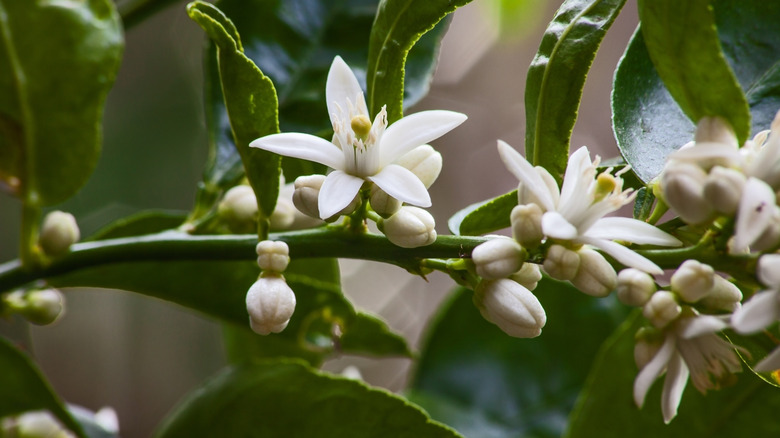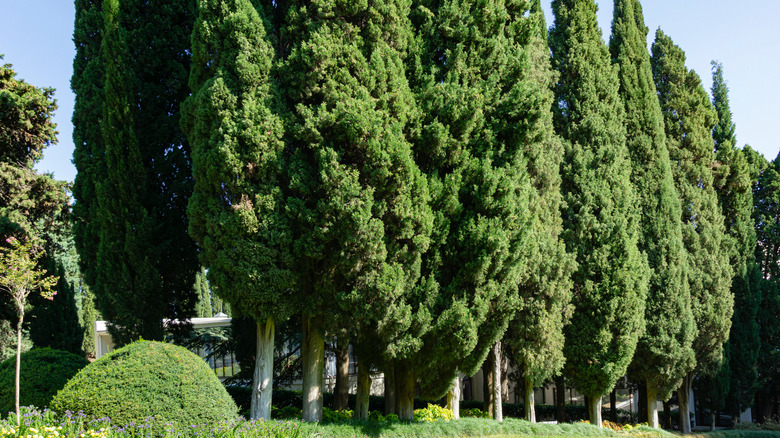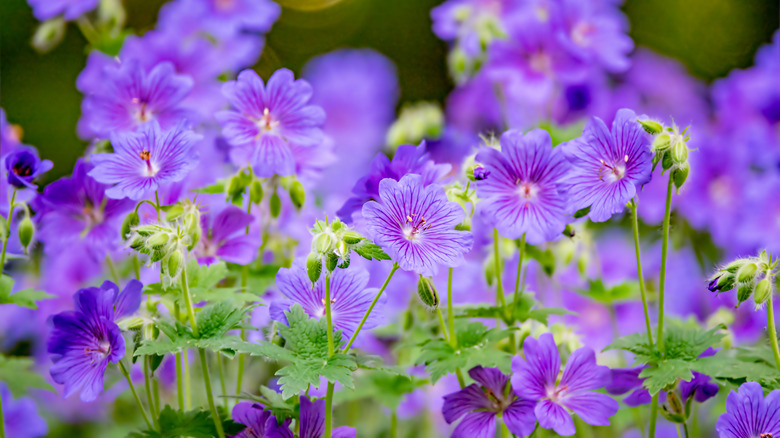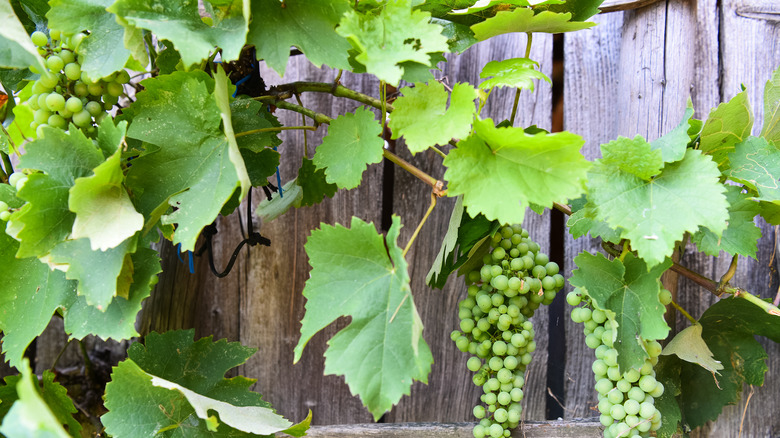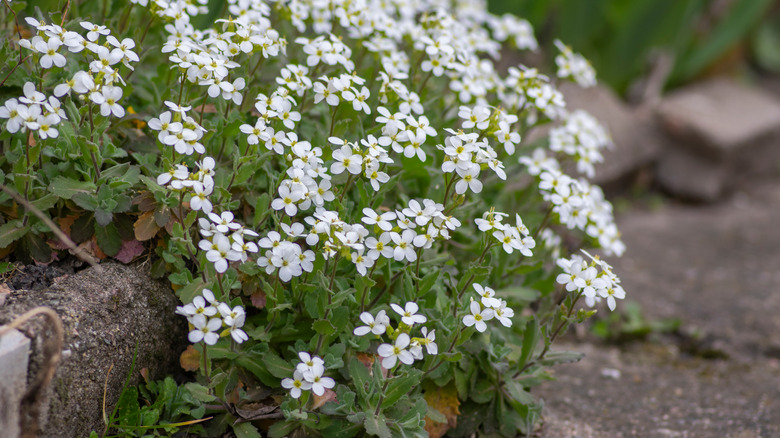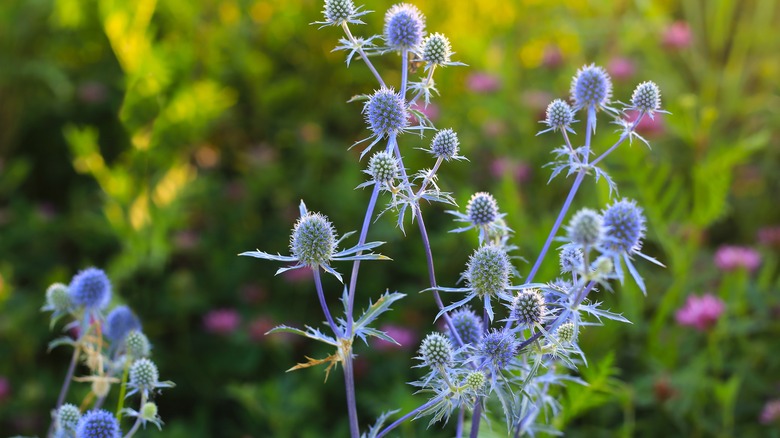15 Plants To Grow In A Mediterranean Garden
Mediterranean gardens are characterized by plants that serve gardeners and families by providing fruits, herbs, shade, and shelter, as well as other things that make life even more enjoyable in the warm and arid environments where they're usually found. Of course, this type of garden refers to the those commonly grown in the part of the world where southern Europe meets northern Africa, including countries such as Albania, Italy, Spain, Egypt, Greece, and more. However, other areas around the globe with similar climates can also provide for these beautiful gardens just as well. Within that group, Pacific Horticulture includes Southern California, Western Australia, and Mexico.
When designing your own garden in this style, keep in mind that, in the Mediterranean region, gardens have a long history of being planted in response to a specific climate that not every plant can tolerate. They make the climatic constraints work for them by choosing easy-to-care-for, low-maintenance, and typically herbaceous plants that love dry summers and mild winters.
Whether you're building a Mediterranean garden for its function or its aesthetic, it's important to realize the purpose and history of its design so you can create something full of the optimal textures, colors, scents, and flavors.
1. Spanish dagger
The Spanish dagger plant (Yucca gloriosa), which is also sometimes called the moundlily yucca, is a member of the Asparagaceae family, according to the University of Arizona. This plant grows quite tall, as high as 10 feet, when cared for properly. In a Mediterranean garden, the Spanish dagger makes for a bright visual accent among other drought resistant plants.
Bloom Season: Summer
USDA Growing Zone: 6 to 10
Growing Conditions: Full sun to partial shade
Soil Type: Sandy and well-draining
Size: 10 feet tall and 8 feet wide
2. Mediterranean spurge
Mediterranean spurge (Euphorbia characias) is a drought-tolerant and low maintenance plant known for its gorgeous foliage and red flowers that appear in the early months of spring. North Carolina State Extension suggests planting this ground cover perennial with other spring favorites such as tulips, daffodils, and candytuft.
Bloom Season: Spring
USDA Growing Zone: 6 to 8
Growing Conditions: Full sun to partial shade
Soil Type: Shallow, rocky, and well-draining
Size: 2 feet tall and 3 feet wide
3. Shrubby bindweed
Shrubby bindweed (Convolvulus cneorum), or the silverbush, is a well-known evergreen dwarf shrub that is native to parts of Africa and southeastern Europe. It's a short-growing perennial with tapered, lanceolate leaves that works well in containers, border gardens, and rock gardens, notes Missouri Botanical Garden.
Bloom Season: Summer
USDA Growing Zone: 8 to 10
Growing Conditions: Full sun
Soil Type: Well-draining
Size: 1 to 2 feet tall and 2 to 3 feet wide
4. Bougainvillea
Bougainvillea (Bougainvillea spp.) is often the first plant people remember when thinking about a visit to the Mediterranean. It's very popular in warm climates that receive little precipitation yet lots of direct sunlight. This brightly blooming flowering bush grows long woody vines that can stretch farther than 20 feet. Clemson Cooperative Extension says that bougainvillea can produce flowers in yellow, orange, pink, white, and purple.
Bloom Season: Spring and summer
USDA Growing Zone: 9 to 11
Growing Conditions: Full sun
Soil Type: Well-draining
Size: 20 to 30 feet tall
5. Cotton lavender
Cotton lavender (Santolina chamaecyparissus) is an aromatic plant typically used as ground cover or grown into a low shrub. This herb, identified by its gray-green leaves and yellow pompom-like flowers, needs lots of direct sunlight and high temperatures. Per North Carolina State Extension, when cared for correctly, it will reward the gardener with fragrant leaves that can be brought inside to keep your home smelling fresh.
Bloom Season: Spring
USDA Growing Zone: 6 to 9
Growing Conditions: Full sun
Soil Type: Sandy and well-draining
Size: 1 to 2 feet tall and 2 to 3 feet wide
6. Corsican hellebore
Corsican hellebore (Helleborus argutifolius) is commonly used in cut flower arrangements in the spring and summer. Its unique, bell-shaped, green hued blossoms add interesting texture and a large burst of freshness to a floral bouquet or Mediterranean garden. As mentioned by the Royal Horticultural Society, the plant has some poisonous qualities, so precautions should be taken when handling it.
Bloom Season: Spring and winter
USDA Growing Zone: 6 to 9
Growing Conditions: Full sun to partial shade
Soil Type: Well-draining
Size: 1 to 3 feet tall and wide
7. Italian bugloss
Italian bugloss (Anchusa azurea), which is more commonly referred to as blue bugloss in some parts of the world, is a member of the Boraginaceae family, also called the forget-me-not family, according to Missouri Botanical Garden. This perennial is one of the few Mediterranean plants that bloom in true blue, so it can make a stunning visual impact on your garden.
Bloom Season: Spring
USDA Growing Zone: 3 to 8
Growing Conditions: Full sun
Soil Type: Well-draining
Size: 3 to 4 feet tall and 1 to 2 feet wide
8. Bay tree
Bay trees (Laurus nobilis) can be grown all over the world today, but no region is as perfect for the tree as its native Mediterranean environment. Bay trees prefer well-drained soil, direct sunlight, and somewhat frequent watering. Though the tree is considered drought-tolerant to an extent, its soil should not be left dry for long, warns University of Wisconsin-Madison.
Bloom Season: Spring
USDA Growing Zone: 7 to 10
Growing Conditions: Full sun
Soil Type: Evenly moist and well-draining
Size: 4 to 10 feet tall
9. Lamb's ear
Lamb's ear (Stachys byzantina) is a plant native to Turkey, Armenia, and Iran, explains Missouri Botanical Garden. The herbaceous perennial gets its name from its fuzzy leaves, which really do resemble the soft ears of a lamb. Though it's technically a flower, the blooms are insignificant. Most often, the lamb's ear plant is grown for its foliage; it's a great choice when used for ground cover throughout a Mediterranean garden.
Bloom Season: Early spring to mid-summer
USDA Growing Zone: 4 to 8
Growing Conditions: Full sun
Soil Type: Well-draining
Size: 18 inches tall and wide
10. Olive tree
Olive trees (Olea europaea) are a species of tree that feature beautifully gnarled roots and trunks. They produce small purple or white blooms in the summer that give way to olives in the fall. These olives can be harvested as fruit or they can be used to make olive oil. North Carolina State Extension mentions that the trees have naturalized to many areas that mimic their native climate. Today they're even considered invasive in Hawaii.
Bloom Season: Summer
USDA Growing Zone: 8 to 10
Growing Conditions: Full sun
Soil Type: Well-draining
Size: 20 to 30 feet tall
11. Italian cypress tree
Italian cypress trees (Cupressus sempervirens) must be grown in well-draining soil and under full sun. As per Oregon State University, they are best used in Mediterranean gardens located in California or areas with similar climates. You can recognize this plant from its tall, upright growth habit, and dark green scale-like leaves.
Bloom Season: Does not flower
USDA Growing Zone: 7 to 8
Growing Conditions: Full sun
Soil Type: Well-draining
Size: 40 to 70 feet tall and 10 to 20 feet wide
12. Purple cranesbill
The purple cranesbill (Geranium × magnificum) needs little maintenance to produce its delightful purple flowers in the summer. This clump-forming perennial can be grown in a few different types of soil, and it doesn't mind some shade either. Though the plant doesn't flower for long, it does produce many blooms during its flowering season for a bold display of color, notes the Royal Horticultural Society.
Bloom Season: Summer
USDA Growing Zone: 5 to 8
Growing Conditions: Full sun to partial shade
Soil Type: Well-draining
Size: Up to 30 inches tall
13. Grapes
Grapes (Vitis vinifera) are produced from a woody vine that can grow to extreme lengths, however, the plant can also be pruned to stay smaller. In a Mediterranean garden, grape vines are used for their ornamental value in addition to their deliciously sweet fruit. According to Purdue University, they can be difficult to grow in cold climates that experience harsh winters.
Bloom Season: Spring and summer
USDA Growing Zone: 6 to 10
Growing Conditions: Full sun to partial shade
Soil Type: Well-draining
Size: Over 100 feet long
14. Caucasian rockcress
Caucasian rockcress (Arabis caucasica) is a fragrant flower that flourishes in rock gardens and border gardens located in a Mediterranean climate. It is considered an easy-to-grow plant because it tolerates drought, infertile soil, and cool weather, explains Cornell University. This plant is usually identified by its toothed gray-green leaves and scented white flowers.
Bloom Season: Spring and summer
USDA Growing Zone: 4 to 7
Growing Conditions: Full sun
Soil Type: Well-draining
Size: 6 to 12 inches tall and 12 to 18 inches wide
15. Sea holly
Blue glitter sea holly (Eryngium planum 'Blue Glitter') can often be found in a cut flower garden, but it can also bring an entirely new vibe to a beautiful Mediterranean garden if you're prepared to care for it. This blue-flowering plant is a profuse bloomer that requires fast-draining soil, direct sunlight, and deep watering on an infrequent basis, as advised by High Country Gardens.
Bloom Season: Summer
USDA Growing Zone: 4 to 9
Growing Conditions: Full sun
Soil Type: Well-draining
Size: 36 to 40 inches tall and 18 to 24 inches wide

